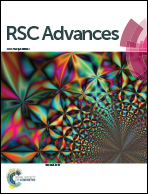Advanced amorphous nanoporous stannous oxide composite with carbon nanotubes as anode materials for lithium-ion batteries
Abstract
An amorphous nanoporous stannous oxide (ANSO) composite with carbon nanotubes (CNTs) electrode material is synthesized by electrodeposition and anodic oxidation methods. The ANSO@CNTs as an anode material for lithium-ion batteries exhibits a highly reversible specific capacity, stable cycling ability and good rate capabilities. The first discharge capacity is as high as 1895.3 mA h g−1 with a reversible capacity of 1608.2 mA h g−1 at a current density of 100 mA g−1. Furthermore, an electrochemical performance with a highly reversible capacity and enhanced rate capability can be found due to the highly uniform distribution and superior electrochemical and mechanical performances of the CNTs. The preparation approach for the ANSO@CNTs anode material reported in this paper may be applied to large-scale production of anode materials for high performance lithium-ion batteries.


 Please wait while we load your content...
Please wait while we load your content...